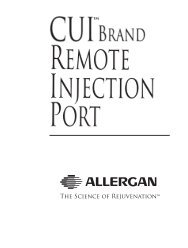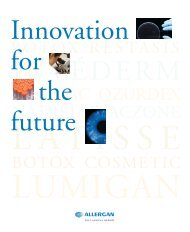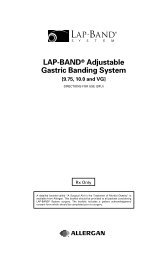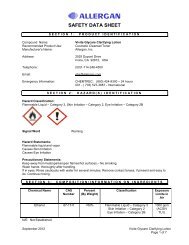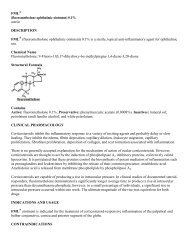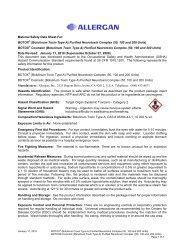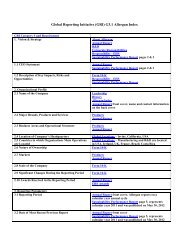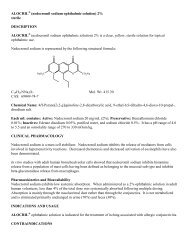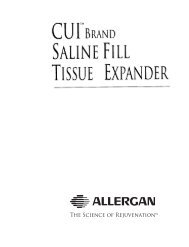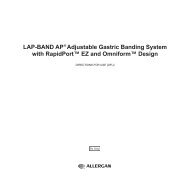zyplast® collagen implant physician package insert - Allergan
zyplast® collagen implant physician package insert - Allergan
zyplast® collagen implant physician package insert - Allergan
Create successful ePaper yourself
Turn your PDF publications into a flip-book with our unique Google optimized e-Paper software.
ZYPLAST ® COLLAGEN IMPLANT<br />
PHYSICIAN PACKAGE INSERT<br />
DESCRIPTION<br />
Zyplast® <strong>collagen</strong> <strong>implant</strong> is a sterile device composed of highly purified<br />
bovine dermal <strong>collagen</strong> that is lightly crosslinked with glutaraldehyde<br />
and dispersed in a phosphate-buffered physiological saline containing<br />
0.3% lidocaine.<br />
MODE OF ACTION<br />
ZYPLAST <strong>collagen</strong> <strong>implant</strong> is introduced into mid to deep dermal tissues<br />
for correction of contour deficiencies. After injection, the suspended<br />
<strong>collagen</strong> forms a soft cohesive network of fibers, which is responsible<br />
for restoring contour. Over a period of months the <strong>implant</strong> is colonized<br />
by host connective tissue cells; once established, the <strong>implant</strong> takes on<br />
the texture and appearance of normal host tissue and is subject to the<br />
same stresses and aging processes.<br />
INDICATIONS AND USAGE<br />
ZYPLAST <strong>collagen</strong> <strong>implant</strong> is indicated for the correction of contour<br />
deficiencies of soft tissue. The etiology and distensibility of the defect,<br />
tissue stress at the <strong>implant</strong> site, and plane of placement of the <strong>implant</strong><br />
will affect the degree and duration of contour restoration. Results of in<br />
vitro and in vivo studies suggest that ZYPLAST <strong>collagen</strong> <strong>implant</strong>,<br />
because it is crosslinked, may persist in tissue to a greater extent than<br />
non-crosslinked Zyderm® <strong>collagen</strong> <strong>implant</strong>; therefore, it is recommended<br />
that during treatment, correction should be limited to no more than<br />
100% of the defect. Two or more <strong>implant</strong> sessions at intervals of at<br />
least two weeks may be required to achieve the desired effect.<br />
Collagen <strong>implant</strong>s have been employed successfully in many areas of<br />
the body to correct distensible acne scars, atrophy from disease or<br />
trauma, glabellar frown lines, nasolabial folds, or defects secondary to<br />
rhinoplasty, skin graft or other surgery, and other soft tissue defects.<br />
Severely indurated, sharply marginated and very superficial lesions<br />
(e.g., ice-pick acne scars, viral pockmarks, and superficial rhytides such<br />
as some perioral lines) have proved difficult to distend and, therefore,<br />
are difficult to correct. If a defect cannot be distended because of<br />
extensive scarring or nonelastic tissue, the course of correction will be<br />
prolonged, if correction is achievable.<br />
Touch-up <strong>implant</strong>ations at 6-18 month intervals will be required to<br />
maintain maximum correction. The interval at which touch-up <strong>implant</strong>ations<br />
are needed depends on the nature of the lesion, the amount of<br />
<strong>implant</strong> introduced, the plane of placement and the stresses that may<br />
exist at corrected sites. For example, ongoing mechanical stresses<br />
eventually cause these defects to recur. Correction tends to persist<br />
longer in areas in which disease processes have become quiescent.<br />
Nevertheless, if a stable level of correction is desired, all patients<br />
should be counselled to anticipate supplemental <strong>implant</strong>ations.<br />
CONTRAINDICATIONS<br />
ZYPLAST <strong>collagen</strong> <strong>implant</strong> therapy must not be initiated if the patient<br />
has a positive response to the required Collagen Test Implant. Refer to<br />
Collagen Test Implant Physician Package Insert for complete instructions<br />
for administration and evaluation of the test <strong>implant</strong>.<br />
ZYPLAST <strong>collagen</strong> <strong>implant</strong> must not be used in patients with severe<br />
allergies manifested by a history of anaphylaxis, or history or presence<br />
of multiple severe allergies.<br />
ZYPLAST <strong>collagen</strong> <strong>implant</strong> contains lidocaine and must not be used in<br />
patients with known lidocaine hypersensitivity.<br />
ZYPLAST <strong>collagen</strong> <strong>implant</strong> must not be used in patients with a history<br />
of allergies to any bovine <strong>collagen</strong> products, including but not limited<br />
to <strong>collagen</strong> injectables, <strong>collagen</strong> <strong>implant</strong>s, hemostatic sponges and <strong>collagen</strong>-based<br />
sutures, because these patients are likely to have hypersensitivity<br />
to ZYPLAST <strong>collagen</strong> <strong>implant</strong>.<br />
ZYPLAST <strong>collagen</strong> <strong>implant</strong> must not be used in patients undergoing or<br />
planning to undergo desensitization injections to meat products, as<br />
these injections can contain bovine <strong>collagen</strong>.<br />
ZYPLAST <strong>collagen</strong> <strong>implant</strong> is contraindicated for use in breast augmentation,<br />
and for <strong>implant</strong>ation into bone, tendon, ligament, or muscle.<br />
WARNINGS<br />
A Collagen Test Implant must be administered and evaluated prior to<br />
soft tissue deficiency correction using ZYPLAST <strong>collagen</strong> <strong>implant</strong>.<br />
(Refer to Collagen Test Implant Physician Package Insert.) Note: The<br />
Collagen Test Implant is non-crosslinked <strong>collagen</strong>, while<br />
ZYPLAST <strong>collagen</strong> <strong>implant</strong> is crosslinked <strong>collagen</strong>. If the<br />
Collagen Test Implant response is equivocal, it is recommended that a<br />
second test <strong>implant</strong>ation be administered in the opposite arm and evaluated<br />
prior to the initiation of treatment.<br />
Some <strong>physician</strong>s have reported the occurrence of connective tissue<br />
diseases such as rheumatoid arthritis, systemic lupus erythematosus,<br />
polymyositis (PM), and dermatomyositis (DM) subsequent to <strong>collagen</strong><br />
injections in patients with no previous history of these disorders. Conflicting<br />
studies have been published (27, 28) in peer reviewed journals regarding<br />
the association between PM/DM and injectable <strong>collagen</strong>. A causal relationship<br />
between <strong>collagen</strong> injections and the onset of PM/DM, or the<br />
other connective tissue diseases listed, has not been established.<br />
Also, an increased incidence of cell-mediated and humoral immunity to<br />
various <strong>collagen</strong>s have been found in systemic connective tissue diseases<br />
such as rheumatoid arthritis, juvenile rheumatoid arthritis, and<br />
progressive systemic sclerosis (scleroderma). 19-24 Patients with these<br />
diseases may thus have an increased susceptibility to hypersensitivity<br />
responses and/or accelerated clearance of their <strong>implant</strong>s when injected<br />
with bovine dermal <strong>collagen</strong> preparations. Therefore, caution should be<br />
used when treating these patients including consideration for multiple<br />
skin testing (see Skin Test Package Insert).<br />
Local necrosis is a rare event which has been observed following <strong>collagen</strong><br />
<strong>implant</strong>ation. Most necroses reported through post-marketing surveillance<br />
have occurred in the glabella. It is thought to result from the<br />
injury, obstruction, or compromise of blood vessels. ZYPLAST <strong>collagen</strong><br />
<strong>implant</strong> is more often injected deeper into the dermis closer to the local<br />
vascular supply than is ZYDERM <strong>collagen</strong> <strong>implant</strong>. Additionally, ZYPLAST<br />
<strong>collagen</strong> <strong>implant</strong> does not undergo syneresis after injection. Therefore,<br />
interruption of the local blood supply may more likely occur with<br />
ZYPLAST <strong>collagen</strong> <strong>implant</strong>. It is recommended that corrections in the<br />
glabellar region be performed using ZYDERM <strong>collagen</strong> <strong>implant</strong> rather<br />
than ZYPLAST <strong>collagen</strong> <strong>implant</strong>.<br />
Patients with a history of dietary beef allergy should be carefully evaluated<br />
before injectable bovine <strong>collagen</strong> therapy, since it is possible that<br />
the <strong>collagen</strong> component of the beef may be causing the allergy. More<br />
than one skin test is highly recommended prior to treating these<br />
patients.<br />
ZYPLAST <strong>collagen</strong> <strong>implant</strong> must not be <strong>implant</strong>ed into blood vessels.<br />
Collagen can initiate platelet aggregation, and <strong>implant</strong>ation of ZYPLAST<br />
<strong>collagen</strong> <strong>implant</strong> into dermal vessels may cause vascular occlusion,<br />
infarction, or embolic phenomena.<br />
PRECAUTIONS<br />
Use of ZYDERM 1 <strong>collagen</strong> <strong>implant</strong> in an individual patient should be limited<br />
to 30 cc over a one-year period. Use of ZYDERM 2 <strong>collagen</strong> <strong>implant</strong><br />
in an individual patient should be limited to 15 cc over a one-year period.<br />
The combination of these products or of ZYDERM in conjunction<br />
with ZYPLAST in an individual patient should be limited to 30 cc over<br />
a one-year period. The safety of injecting greater amounts on an annual<br />
basis has not been established.<br />
ZYPLAST <strong>collagen</strong> <strong>implant</strong> should be used with caution in patients with<br />
histories of allergic reactions to other substances, as injectable <strong>collagen</strong><br />
use has been associated with allergic hypersensitivity responses,<br />
especially in patients with such histories.<br />
The injection of ZYPLAST <strong>collagen</strong> <strong>implant</strong> carries an inherent, yet minimal,<br />
risk of infection, as does any transcutaneous procedure.<br />
Use of ZYPLAST <strong>collagen</strong> <strong>implant</strong> at specific sites in which an active<br />
inflammatory process (skin eruptions such as cysts, pimples, rashes, or<br />
hives) or infection is present should be deferred until the underlying<br />
process has been controlled.<br />
The safety of ZYPLAST <strong>collagen</strong> <strong>implant</strong> for use during pregnancy or in<br />
infants has not been established.<br />
ZYPLAST <strong>collagen</strong> <strong>implant</strong> should be used with caution in patients on<br />
immunosuppressive therapy.<br />
Patients who are using substances which reduce coagulation, such as<br />
aspirin and non-steroidal anti-inflammatory drugs may, as with any<br />
injection, experience increased bruising or bleeding at injection sites.<br />
ZYPLAST <strong>collagen</strong> <strong>implant</strong> is not recommended for use in the periorbital<br />
area. Overcorrection of the vermilion border of the lip has been<br />
slow to resolve due to minimal tissue stresses at this site. Therefore,<br />
caution is advised for ZYPLAST <strong>collagen</strong> <strong>implant</strong> use in this area.<br />
Clinical experience with injectable <strong>collagen</strong> <strong>implant</strong>s was not available<br />
prior to 1976; the safety of this product for a longer duration is not<br />
known.<br />
Since it has been reported that host <strong>collagen</strong> may be deposited at the<br />
site of <strong>collagen</strong> <strong>implant</strong>ation, the patient should be informed that part<br />
or all of the correction may last for 2 years or more.<br />
TREATMENT RESPONSES<br />
Transient or minimal swelling, mild redness, and discomfort will probably<br />
occur at the <strong>implant</strong> site immediately following <strong>implant</strong>ation.<br />
Increasing discomfort or swelling, or spreading redness should be<br />
brought immediately to the <strong>physician</strong>’s attention.<br />
Transient pain and tenderness at injection sites has been associated<br />
with the injection of the <strong>collagen</strong> <strong>implant</strong>s.<br />
On occasion, transient painless bruising or discoloration has been noted<br />
to develop at one or more of the <strong>implant</strong>ation sites. Resolution has<br />
always been spontaneous.<br />
Fewer than 1% of patients receiving ZYDERM <strong>collagen</strong> <strong>implant</strong> have at<br />
some time reported an intermittent swelling response, involving moderate<br />
induration at the <strong>implant</strong> site and edema within the surrounding<br />
tissues. In some cases, these responses have been found to be associated<br />
with antibodies to bovine <strong>collagen</strong>. At times this has been accompanied<br />
by mild pruritis or minimal erythema which may persist for a<br />
period up to several months. These reactions may last only a few hours<br />
and are usually associated with causes of peripheral vasodilatation,<br />
such as consumption of alcohol, prolonged exposure to sun and/or<br />
heat, exercise, and flare-ups of hay fever and other causes of nasal and<br />
sinus congestion. To date, these reactions have been self-limiting and<br />
have not been shown to affect adversely the long-term success of<br />
<strong>collagen</strong> <strong>implant</strong> correction, although they may persist throughout the<br />
life of the <strong>implant</strong>.<br />
Infections at <strong>collagen</strong> <strong>implant</strong> sites have occurred in fewer than one per<br />
thousand treated patients, and reactivation of a pre-existing herpes<br />
simplex infection at <strong>implant</strong>ation sites has been reported in fewer than<br />
one per ten thousand patients. These responses resolved quickly and<br />
without sequelae.<br />
As with any injection into the head or neck, the injected material may<br />
be inadvertently <strong>implant</strong>ed into a blood vessel. Forceful injection into<br />
dermal arterial branches of the face and scalp could cause retrograde<br />
movement of the <strong>implant</strong> material into retinal arteries, resulting in vascular<br />
occlusion. Such a complication, although unlikely, has been<br />
reported with the use of ZYDERM <strong>collagen</strong> <strong>implant</strong> in one patient, and<br />
resulted in the sudden and permanent loss of vision in one eye. Similar<br />
complications have been associated with other injectable preparations,<br />
including corticosteroids, local anesthetics, and angiographic agents.<br />
These findings emphasize the importance of avoiding <strong>implant</strong>ation into<br />
blood vessels.<br />
ADVERSE REACTIONS<br />
Patients treated intradermally with ZYPLAST <strong>collagen</strong> <strong>implant</strong> have<br />
reported temporary palpable lumpiness or visible material (milia-like<br />
yellow or white papules) at injection sites. Both of these types of<br />
treatment responses resolved spontaneously without sequelae, and are<br />
believed to reflect reduced shrinkage of crosslinked <strong>implant</strong>s due to<br />
water resorption, compared with non-crosslinked <strong>collagen</strong> <strong>implant</strong>s.<br />
Sensitization reactions to injectable <strong>collagen</strong> <strong>implant</strong>s have occurred in<br />
1-2% of treated patients. Most reactions have been of a hypersensitivity<br />
nature and have consisted of erythema, swelling, induration and/or<br />
urticaria at <strong>implant</strong>ation sites. Often these reactions have occurred<br />
following an unrecognized or unreported positive <strong>collagen</strong> skin test.<br />
Typically, allergic reactions persist between one and nine months, with<br />
an average duration of four months. These reactions may be intermittent<br />
or continuous in nature. In rare instances, reactions have resolved<br />
in one or two weeks, or have persisted for more than one year. Although<br />
several forms of therapy (antihistamines, NSAIDS, oral, topical and<br />
intralesional steroids) have been tried, usually they resulted in only<br />
temporary improvement. In most cases, time has proved to be the<br />
determining factor in the resolution of these reactions. In rare instances,<br />
patients have been left with residual firmness at the site of a resolved<br />
adverse reaction.<br />
On rare occasions, abscess formation has occurred at <strong>implant</strong>ation sites.<br />
In some cases this reaction has been associated with elevated titers of<br />
anti-bovine <strong>collagen</strong> antibodies, and can be multiple or recurrent. These
eactions develop weeks to months following injections and may result<br />
in induration and/or scar formation. Most of the remaining responses<br />
occurred in patients who became sensitized to <strong>collagen</strong> <strong>implant</strong>s at<br />
some point during their course of treatment.<br />
The antigenic specificity of ZYPLAST <strong>collagen</strong> <strong>implant</strong> has been determined<br />
to be identical to that of ZYDERM <strong>collagen</strong> <strong>implant</strong>. During clinical<br />
trials and post-marketing surveillance, the incidence of hypersensitivity<br />
responses to ZYPLAST <strong>collagen</strong> <strong>implant</strong> has been significantly lower<br />
than to ZYDERM <strong>collagen</strong> <strong>implant</strong>; however, because of the potential<br />
for prolonged local availability of antigen, it is possible that the longterm<br />
rate of response to ZYPLAST <strong>collagen</strong> <strong>implant</strong> may exceed the<br />
low rate experienced to date.<br />
Systemic complaints have been reported by fewer than 0.5% of <strong>collagen</strong><br />
<strong>implant</strong> patients. During clinical testing and subsequent monitoring<br />
of patient complaints following exposure to ZYPLAST <strong>collagen</strong> <strong>implant</strong>,<br />
a variety of systemic complaints have been reported. These reports<br />
have included flu-like symptoms (fever, headache, myalgia, neuralgia,<br />
nausea, malaise, or dizziness); pruritis; rash; transient visual disturbances<br />
including blurred vision; tingling and numbness; transient polyarthralgia;<br />
and various systemic diseases including immune-mediated<br />
diseases. Rare anaphylactoid responses have been reported, including<br />
acute episodes of hypotension, difficulty in breathing, tightness in<br />
chest, and/or shortness of breath.<br />
Localized necrosis and/or sloughing, resulting in a scab and/or a scar,<br />
has occurred following interruption of blood flow such as through blood<br />
vessel laceration or occlusion. The extent of necrosis has varied and is<br />
in the pattern of the tissue served by the vessel involved. This phenomenon<br />
has been reported more frequently in the glabellar region of<br />
the face than in other areas; nevertheless, the incidence of this scab or<br />
scar formation is less than 1%, and may occur in conjunction with<br />
either infection and/or hypersensitivity response. In these patients,<br />
<strong>implant</strong>ation can be followed by prolonged blanching or development of<br />
ecchymosis at the treatment site. It is possible that overdistention of<br />
tissue in areas of compromised vascularity may lead to similar complications,<br />
caused by interruption of blood supply to an injection site.<br />
To report an adverse reaction, phone the Medical Monitoring Department,<br />
McGhan Medical Corporation, toll-free: (800) 722-2007.<br />
DIRECTIONS FOR USE<br />
NOTE: ZYPLAST <strong>collagen</strong> <strong>implant</strong> should be stored at standard refrigerator<br />
temperatures. D O NOT FREEZE.<br />
1. Prior to a Collagen Test Implant, the patient should be provided<br />
with a copy of the Patient Brochure.<br />
2. Prior to treatment with ZYPLAST <strong>collagen</strong> <strong>implant</strong>, the results of<br />
the test <strong>implant</strong>ation must be carefully evaluated; the patient must<br />
not have a response to the required Collagen Test Implant. For a<br />
complete discussion of the Collagen Test Implant, refer to the<br />
Collagen Test Implant Physician Package Insert supplied with test<br />
syringes.<br />
3. Prior to treatment with ZYPLAST <strong>collagen</strong> <strong>implant</strong>, the patient<br />
should be fully apprised of the indications, contraindications, warnings,<br />
precautions, treatment responses, adverse reactions, and<br />
method of administration. Patients also should be advised that supplemental<br />
touch-up <strong>implant</strong>ations will be required to maintain maximum<br />
correction.<br />
4. A complete medical history should be obtained to determine<br />
whether the patient is an appropriate candidate for treatment with<br />
ZYPLAST <strong>collagen</strong> <strong>implant</strong>.<br />
5. The patient’s soft tissue deficiencies should be characterized with<br />
regard to etiology, distensibility, stress at the site, and depth of<br />
lesion. Pretreatment photographs are recommended.<br />
6. After ensuring that the patient has thoroughly washed the treatment<br />
area with soap and water, the area should be swabbed with<br />
alcohol or other antiseptic.<br />
7. ZYPLAST <strong>collagen</strong> <strong>implant</strong> is <strong>implant</strong>ed through a fine-gauge<br />
needle. The needle should be placed into the plane(s) of apparent<br />
deformity and the defect should not be overcorrected. Best results<br />
with ZYPLAST <strong>collagen</strong> <strong>implant</strong> are achieved in defects requiring<br />
mid to deep dermal <strong>implant</strong> placement. The rate and degree of<br />
subsidence of correction in the <strong>implant</strong>ed area varies with patient,<br />
treatment site, and plane of <strong>implant</strong> placement. Correction should<br />
be conservative during initial treatment. Clinical experience has<br />
shown that overcorrection has been slow to resolve in the periorbital<br />
area and in treatment sites around the vermilion border of the<br />
lip. Therefore, caution is advised for ZYPLAST <strong>collagen</strong> <strong>implant</strong> use<br />
in these areas. Severely indurated defects such as scars, which<br />
initially resist distention, may require several treatment sessions<br />
before desired correction is obtained.<br />
Needles may become occluded or dull during a treatment session,<br />
and replacement may be necessary.<br />
8. Vigorous massage of the treated areas is recommended following<br />
<strong>implant</strong>ation.<br />
9. Successive <strong>implant</strong>ations at intervals of two or more weeks may be<br />
necessary to achieve the desired level of correction.<br />
10. The <strong>physician</strong> should instruct the patient to report to her/him any<br />
evidence of adverse texture change in the surrounding <strong>implant</strong>ation<br />
site. Other problems possibly associated with the use of ZYPLAST<br />
<strong>collagen</strong> <strong>implant</strong> should be promptly brought to the attention of<br />
the <strong>physician</strong>.<br />
11. The syringe and any unused material should be discarded after a<br />
single treatment visit.<br />
HOW SUPPLIED<br />
ZYPLAST <strong>collagen</strong> <strong>implant</strong> is sterile and supplied in individual treatment<br />
syringes <strong>package</strong>d with fine-gauge needles, ready for use.<br />
To place an order, phone toll-free: (800) 624-4261.<br />
STORAGE DIRECTIONS<br />
ZYPLAST <strong>collagen</strong> <strong>implant</strong> should be stored at standard refrigerator<br />
temperatures. D O NOT FREEZE.<br />
ZYPLAST <strong>collagen</strong> <strong>implant</strong> has an off-white opaque appearance. In the<br />
event that a syringe contains material that is clear (like water), do not<br />
use the syringe and notify McGhan Medical Corporation immediately at<br />
(800) 624-4261.<br />
CAUTION:FEDERAL LAW RESTRICTS THIS DEVICE TO<br />
SALE, DISTRIBUTION, OR USE BY, OR ON THE<br />
LAWFUL ORDER OF A LICENSED PHYSICIAN OR<br />
AN ORAL AND MAXILLOFACIAL SURGEON.<br />
REFERENCES<br />
1. Stegman SJ, Tromovitch TA: Implantation of <strong>collagen</strong> for depressed<br />
scars. J Dermatol Surg Oncol 6:450-453, 1980.<br />
2. Bailin PL, Bailin MD: Correction of depressed scars following Mohs’<br />
surgery:The role of <strong>collagen</strong> <strong>implant</strong>ation. J Dermatol Surg<br />
Oncol 8:845-849, 1982.<br />
3. Cucin RL, Barek D: Complications of injectable <strong>collagen</strong> <strong>implant</strong>s.<br />
Plast Reconstr Surg 71:731, 1983.<br />
4. Madison WA: Guinea pig skin sensitization studies with glutaraldehyde<br />
cross-linked <strong>collagen</strong> gel (GAX). Hazelton Raltech Inc., study<br />
#717766, 1983.<br />
5. Swanson NA, Stoner JR, Siegle RJ, et al: Treatment site reactions<br />
to ZYDERM <strong>collagen</strong> <strong>implant</strong>ation. J Dermatol Surg Oncol<br />
9:377-380, 1983.<br />
6. Kaplan EN, Falces E, Tolleth H: Clinical utilization of injectable <strong>collagen</strong>.<br />
Ann Plast Surg 10:437-451, 1983.<br />
7. Klein AW: Implantation techniques for injectable <strong>collagen</strong>: Two-andone-half<br />
years of personal clinical experience. J A m Acad<br />
Dermatol 9:224-228, 1983.<br />
8. Kamer FM, Churukian MM: The clinical use of injectable <strong>collagen</strong>: A<br />
three-year retrospective study. Arch Otolaryngol 110:93-98,<br />
1984.<br />
9. Tromovitch TA, Stegman SJ, Glogau RG: Zyderm <strong>collagen</strong>:<br />
Implantation techniques. J A m Acad Dermatol 10:273-278,<br />
1984.<br />
10. Siegle RJ, McCoy JP, Schade W, et al: Intradermal <strong>implant</strong>ation of<br />
bovine <strong>collagen</strong>: Humoral responses associated with clinical reactions.<br />
Arch Dermatol 120:183-187, 1984.<br />
11. Glogau RG, Stegman SJ: Zyderm Collagen for <strong>implant</strong>ation:<br />
Problems for consideration. In Controversies in<br />
Dermatology Philadelphia, Saunders, 1984, pp 294-297.<br />
12. Cooperman LS, Michaeli D: The immunogenicity of injectable <strong>collagen</strong>:<br />
I. A one-year prospective study. J A m Acad Dermatol<br />
10:638-646, 1984.<br />
13. Cooperman LS, Michaeli D: The immunogenicity of injectable <strong>collagen</strong>:<br />
II. A retrospective review of seventy-two tested and treated<br />
patients. J A m Acad Dermatol 10:647-651, 1984.<br />
14. Klein AW, Rish DC: Injectable Collagen Update. J D e r m a t o l S u r g<br />
Oncol 10:519-522, 1984.<br />
15. Cooperman LS, Mackinnon V, Bechler G, Pharriss BB: Injectable <strong>collagen</strong>:<br />
A six-year clinical investigation. Aesth Plast Surg 9:145-<br />
152, 1985.<br />
16. Tolleth H: Long-term efficacy of <strong>collagen</strong>. Aesth Plast Surg<br />
9:155-158, 1985.<br />
17. Burke KE, Naughton G, Cassai N: A histological, immunological, and<br />
electron microscopic study of bovine <strong>collagen</strong> <strong>implant</strong>s in the<br />
human. Ann Plast Surg 14:515-522, 1985.<br />
18. Kligman AM, Armstrong RC: Histologic response to intradermal<br />
Zyderm and Zyplast (glutaraldehyde cross-linked) <strong>collagen</strong> in<br />
humans. J Dermatol Surg Oncol 12:351-357, 1986.<br />
19. Stuart JM, Huffstutter EH, Townes AS, Kang AH: Incidence and<br />
specificity of antibodies to types I, II, III, IV, and V <strong>collagen</strong> in<br />
rheumatoid arthritis and in other rheumatic diseases as measured<br />
by 125 I-radioimmunoassay. Arthritis Rheum 26:832-840,<br />
1983.<br />
20. Stuart JM, Postlethwaite AE, Huffstutter EH, Townes AS, Kang AH:<br />
Cell-mediated immunity to <strong>collagen</strong> and <strong>collagen</strong> alpha-chains in<br />
rheumatoid arthritis and other rheumatic diseases. A m J M e d<br />
69:13-18, 1980.<br />
21. Claque RB, Shaw MJ, Lennox Holt PJ: Incidence of serum anti-bodies<br />
to native type I and type II <strong>collagen</strong>s in patients with inflammatory<br />
arthritis. Ann Rheum Dis 39:201-206, 1980.<br />
22. Rosenberg AM, Hunt DWC, Petty RE: Antibodies to native <strong>collagen</strong><br />
in childhood rheumatic diseases. J Rheumatol 11:421-424,<br />
1984.<br />
23. Stuart JM, Postlethwaite AE, Kang AH: Evidence of cell-mediated<br />
immunity to <strong>collagen</strong> in patients with progressive systemic sclerosis.<br />
J Lab Clin Med 88:601-607, 1976.<br />
24. Mackel AM, DeLustro F, Harper FE, LeRoy EC: Antibodies to <strong>collagen</strong><br />
in scleroderma. Arthritis Rheum 25:522-531, 1982.<br />
25. Barr RJ, King RD, McDonald RM, et al: Necrobiotic granulomas associated<br />
with bovine <strong>collagen</strong> test site injections. J A m Acad<br />
Dermatol 6:867-869, 1982.<br />
26. Brooks N: A foreign body granuloma produced by an injectable <strong>collagen</strong><br />
<strong>implant</strong> at a test site. J D e r matol Surg Oncol 8:111-<br />
114, 1982.<br />
27. Cukier J, Beauchamp R, Spindler J, Spindler S, Lorenzo C and<br />
Trentham D: Association between bovine <strong>collagen</strong> dermal <strong>implant</strong>s<br />
and a dermatomyositis or a polymyositis-like syndrome. A n n<br />
Internal Med 118:920-928, 1993.<br />
28. Rosenberg M and Reichlin M: Is there an association between<br />
injectable <strong>collagen</strong> and polymyositis/dermatomyositis? Arth<br />
Rheum37:747-753, 1994.<br />
A complete bibliography on Injectable Collagen Implant may be<br />
requested from McGhan Medical Corporation.<br />
McGhan Medical Corporation<br />
48490 Milmont Drive<br />
Fremont, CA 94538 - USA<br />
© 2000 McGhan Medical Corporation M760-A 10/00




